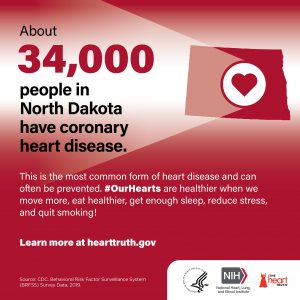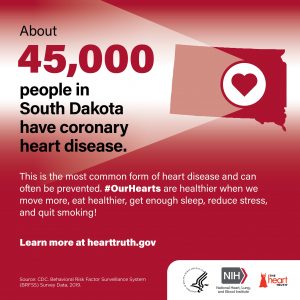
Heart disease is a leading cause of death for both men and women in the United States. Most middle-aged and young adults have one or more risk factors for heart disease, such as diabetes, high blood pressure, high cholesterol, or being a smoker or overweight. Having multiple risk factors increases your risk for heart disease. As healthcare professionals, we encourage individuals to practice heart-healthy behaviors, including being physically active, maintaining a healthy weight, a nutritious diet, quitting smoking, reducing stress, getting quality sleep and being aware of health health statistics.
Evidence also shows people who have close relationships at home, work, or in their community tend to be healthier and live longer. One reason, according to the National Heart, Lung, and Blood Institute (NHLBI), is that we’re more successful at meeting our health goals when we work on them with others.
NHLBI launched the #OurHearts movement to inspire us to protect and strengthen our hearts with the support of others.


Why Connecting is Good for Your Heart
Feeling connected with others and having positive, close relationships benefit our overall health, including our blood pressure and weight. Having people in our lives who motivate and care for us helps. Below are resources to help inspire you, your patients, your family and community to join with others, even if you can’t be physically together, to improve overall heart health.
Additional Heart-Healthy Resources
- Heart-healthy lifestyle tips
- NHLBI’s Move More fact sheet for ideas to get and keep you moving
- Dietary Approaches to Stop Hypertension (DASH) eating plan
- Heart-Healthy Eating
- BeTobaccoFree.hhs.gov and Smokefree.gov
- NHLBI’s Healthy Blood Pressure for Healthy Hearts: Tracking Your Numbers worksheet
- Health and community professionals can use the materials in this toolkit to raise awareness about heart health and the importance of social support for meeting health goals
Visit #OurHearts for inspiration on what others are doing together for their heart health; join and share your message as an inspiration to others.
 Through the Great Plains Quality Care Coalition, we are promoting the prevention and management of chronic diseases by supporting providers in preventing cardiovascular events. Healthy behaviors directly contribute to positive health outcomes. Chronic disease self-management education programs also impact the development of long-term change for a healthy lifestyle. Improving health outcomes related to chronic conditions must be a joint effort between healthcare professionals, the community and the individual. From identifying at-risk individuals to providing self-management education and support, every individual contributes to and benefits from a collaborative approach. Learn more.
Through the Great Plains Quality Care Coalition, we are promoting the prevention and management of chronic diseases by supporting providers in preventing cardiovascular events. Healthy behaviors directly contribute to positive health outcomes. Chronic disease self-management education programs also impact the development of long-term change for a healthy lifestyle. Improving health outcomes related to chronic conditions must be a joint effort between healthcare professionals, the community and the individual. From identifying at-risk individuals to providing self-management education and support, every individual contributes to and benefits from a collaborative approach. Learn more.
